

Saturn, Saturn Information, Rings Facts, News, Photos. The Ringed Planet Saturn was the most distant of the five planets known to the ancients.
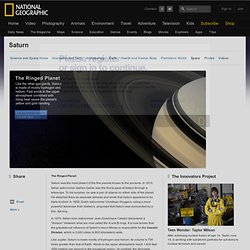
In 1610, Italian astronomer Galileo Galilei was the first to gaze at Saturn through a telescope. To his surprise, he saw a pair of objects on either side of the planet. He sketched them as separate spheres and wrote that Saturn appeared to be triple-bodied. In 1659, Dutch astronomer Christiaan Huygens, using a more powerful telescope than Galileo's, proposed that Saturn was surrounded by a thin, flat ring. In 1675, Italian-born astronomer Jean-Dominique Cassini discovered a "division" between what are now called the A and B rings. Like Jupiter, Saturn is made mostly of hydrogen and helium. Saturn's ring system is the most extensive and complex in the solar system, extending hundreds of thousands of kilometers from the planet. Many Moons Saturn has 52 known natural satellites, or moons, and there are probably many more waiting to be discovered. Voyagers 1 and 2 flew by and photographed Saturn in 1981. Saturn. Saturn means: Saturn was the Roman god of agriculture.
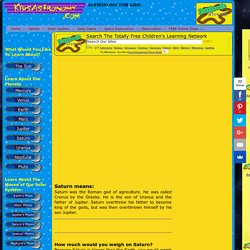
He was called Cronus by the Greeks. He is the son of Uranus and the father of Jupiter. Saturn overthrew his father to become king of the gods, but was then overthrown himself by his son Jupiter. How much would you weigh on Saturn? Because Saturn is bigger than the Earth, you would weigh more on Saturn than you do here. The Planet In many ways, Saturn is similar to Jupiter, but it is much smaller. Saturn is the least dense planet in our Solar System. Because Saturn is such a lightweight planet and it spins so fast, Saturn is not perfectly round like most of the other planets. The Rings Saturn is most well-known for its rings. Moons:Saturn has 53 official moons and 9 provisional (unofficial) moons. To learn more about these worlds Click Here. Saturn's Moons. Saturn's Moons The dozens of icy moons orbiting Saturn vary drastically in shape, size, surface age and origin.
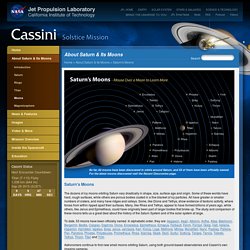
Some of these worlds have hard, rough surfaces, while others are porous bodies coated in a fine blanket of icy particles. All have greater or smaller numbers of craters, and many have ridges and valleys. Some, like Dione and Tethys, show evidence of tectonic activity, where forces from within ripped apart their surfaces. Many, like Rhea and Tethys, appear to have formed billions of years ago, while others, like Janus and Epimetheus, could have originally been part of larger bodies that broke up. To date, 53 moons have been officially named. Astronomers continue to find new small moons orbiting Saturn, using both ground-based observatories and Cassini's own imaging cameras. For more information on the latest moons discovered visit the Recent Discoveries page and the Icy Satellites publications listing. Diversity of Worlds. Rings. Rings Beautiful, glamorous and mysterious, Saturn's rings are among the most recognizable features in the solar system.
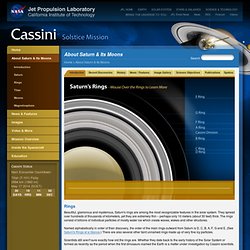
They spread over hundreds of thousands of kilometers, yet they are extremely thin – perhaps only 10 meters (about 30 feet) thick. The rings consist of billions of individual particles of mostly water ice which create waves, wakes and other structures. About Saturn & Its Moons. Introduction On June 30, 2004, the Cassini spacecraft entered orbit around Saturn to begin the first in-depth, up-close study of the ringed planet and its domain.
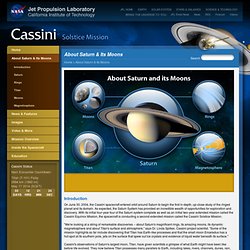
As expected, the Saturn System has provided an incredible wealth of opportunities for exploration and discovery. With its initial four-year tour of the Saturn system complete as well as an initial two-year extended mission called the Cassini Equinox Mission, the spacecraft is conducting a second extended mission called the Cassini Solstice Mission. "We're looking at a string of remarkable discoveries -- about Saturn's magnificent rings, its amazing moons, its dynamic magnetosphere and about Titan's surface and atmosphere," says Dr.
Linda Spilker, Cassini project scientist. Cassini's observations of Saturn's largest moon, Titan, have given scientists a glimpse of what Earth might have been like before life evolved. Why the "Cassini Solstice Mission? " Science Objectives. Magnetosphere. Magnetosphere Forces deep inside Saturn create a giant magnetic bubble around the planet, called the magnetosphere, which exerts a powerful influence on particles that float through space near the planet.

Saturn's magnetic field creates this bubble as material cycles deep within the planet's fluid interior. In a similar way, Earth's magnetic field creates a much smaller magnetosphere that protects us from harmful particles emitted by the sun and other space phenomena.